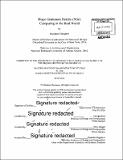Shape Grammars Reality (SGr) : computing in the real world
Author(s)
Vlavianos, Nikolaos
DownloadFull printable version (12.70Mb)
Alternative title
Shape Grammars Reality : computing in the real world
SGr : computing in the real world
Other Contributors
Massachusetts Institute of Technology. Department of Architecture.
Advisor
George Stiny and Terry Knight.
Terms of use
Metadata
Show full item recordAbstract
As a rule, architects calculate, draw, annotate, write, diagram, model, map, photograph, animate, or simply visualize objects, spaces, territories, and processes. They make visual and verbal representations compiling ideas that they have "seen" from direct sensory observations and past memories. Shape Grammars Reality (SGR) allows architects to apply design rules in the real world, by utilizing the idea of calculating with shapes. The current applications of the computational theory of Shape Grammars use primarily sketching on tracing paper with conventional tools. SGR proposes a user interface on the intersection between Augmented Reality (AR) technologies and eye-tracking research. By using Virtual Reality headsets, a designer is able to brainstorm-draft in real time, by applying basic schemas and transformation rules in the smartphone' SGr app. The combination of shape rules and Augmented Reality of this thesis is unique since the current design tools within the ecology of Virtual Reality (VR) and Augmented Reality (AR) applications are not rule-based. The designer explores possibilities by inventing his/her own library of schemas through seeing. Given the fact that seeing is by definition a non-linear process, SGR allows the emergence of shapes in design via real time interaction between the reality of a space and the design intention of the user.
Description
Thesis: S.M., Massachusetts Institute of Technology, Department of Architecture, 2016. Cataloged from PDF version of thesis. Includes bibliographical references (pages 72-73).
Date issued
2016Department
Massachusetts Institute of Technology. Department of ArchitecturePublisher
Massachusetts Institute of Technology
Keywords
Architecture.